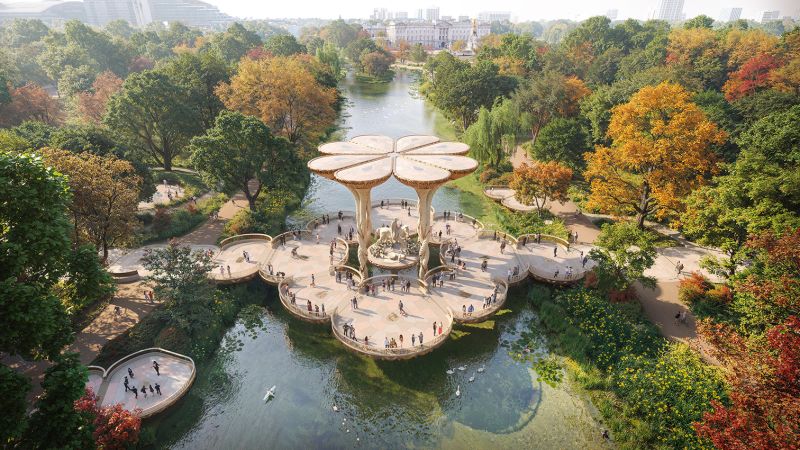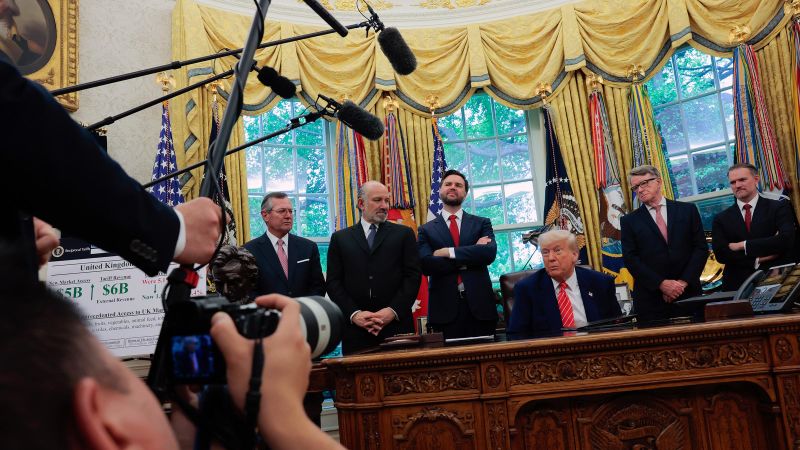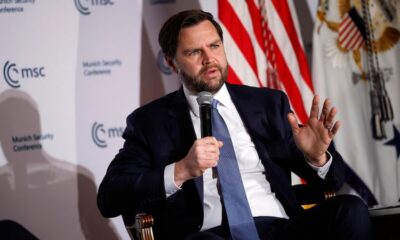London
CNN
—
A pair of gently curved bridges, a bronze oak tree and a lily pad-inspired walkway are among the standout features of five shortlisted designs for Queen Elizabeth II’s official memorial site in central London.
The national memorial will be built in St. James’s Park, near Buckingham Palace in the heart of the British capital.
The finalists, unveiled Wednesday, include some of the UK’s most prominent architecture firms, including Foster + Partners, which designed London’s City Hall and 30 St. Mary Axe (known as The Gherkin), and Heatherwick Studios, the firm behind New York City’s Vessel structure.
A panel from The Queen Elizabeth Memorial Committee, which was jointly established by the British government and Royal Household, will announce a winning proposal this summer, according to a press release. The memorial is expected to be unveiled in 2026, marking what would have been the late Queen’s centenary.

The design brief asked for “an emotionally powerful place” that celebrates Elizabeth II’s “extraordinary life of service,” while providing the public with a space for reflection.
“She was part of our national identity and helped to define our values, she gave us a sense of continuity through times of great change, she was integral to recognizing achievement and she exemplified service and duty, strengthened by faith and leavened by pragmatism, optimism and humor,” said committee chair Lord Janvrin, the late Queen’s former private secretary, in the press release.
“The masterplan design needs to seek inspiration from all this,” he added. “The memorial must be — simply — a beautiful place, a place to visit with friends, a place to gather, to enjoy, and to reflect on an extraordinary life.”
The public can view the finalists’ designs as part of an online exhibition and can provide feedback until May 19.

To honor Britain’s longest-reigning monarch, Heatherwick Studio proposed an entry with a lily-themed bridge at its heart (pictured top). In a video introducing the design, the firm’s founder Thomas Heatherwick said Elizabeth II’s values of “togetherness and unity” led his team to conceptualize a “Bridge of Togetherness” that would serve as a gathering place in the park.
The design features a sculpture of the late monarch protected by a canopy of “sculptural lilies” at the center of a limestone bridge. The proposal also includes a pathway of 70 limestone “lily pads” signifying the Queen’s 70-year reign, as well as plants that held significance for her.
“Like her legacy, it is quietly monumental,” reads the firm’s entry. “A memorial grown from the landscape, open to people throughout the world from every walk of life.”
Another design looking to themes of harmony was proposed by Foster + Partners, which was inspired by British architect John Nash’s 1820s remodeling of St. James’s Park.

The design consists of gardens connected by a network of meandering paths and linked by a “Unity Bridge” symbolizing the Queen as “a powerful force for bringing together people, nations, charities, the Commonwealth, and the Armed Forces,” the firm’s founder, architect Norman Foster, said in a video entry. The pathways will feature Elizabeth II’s words, both as audio installations and inscriptions on the path, including a quote from her 1953 coronation speech: “Throughout all my life and with all my heart I shall strive to be worthy of your trust.”
Proposed sculptures include new figurative statues of the Queen and Prince Philip, as well as a “Wind Sculpture” designed by the British artist Yinka Shonibare, intended to serve as a place of “reflection and shared experience.”
The proposal from landscape architecture studio J&L Gibbons centers on a vision of the late Queen as “the nation’s bedrock” by incorporating a bridge made of literal bedrock. Its layout also “invites forest bathing” in a series of glades surrounded by trees. In its proposal video, the firm said its design represents a quote from the Queen’s 1966 Christmas broadcast, in which she spoke to breathing “gentleness and care into the harsh progress of mankind.”
Also borrowing from nature is landscape architect Tom Stuart-Smith, whose proposal incorporates a replica of a centuries-old oak tree from Windsor Great Park, once the private hunting grounds of the late Queen’s former residence, Windsor Castle.
Stuart-Smith’s team would digitally scan the tree before casting it as a full-size bronze sculpture. Called “The Queen’s Oak” and situated beside a gently curved bridge, the sculpture would be the centerpiece of the site, its lacquered leaves appearing like a “golden mirage reflected in the lake” at night, according to the firm’s entry.
Other features include bronze casts of flowers from various Commonwealth countries, as well as a “sonic soundscape” playing recorded memories from people whose lives were impacted by Elizabeth II.

To create a contemplative experience, architecture firm WilkinsonEyre, which recently restored London’s Battersea Power Station, proposed pathways with “threads” symbolizing the Queen’s life. Visitors can follow each of the threads, which are built around seven themes, including family, nature and the Commonwealth, representing her seven decades of service.
A pair of bridges, set on two different levels, would give visitors views of the park, royal palaces and the London skyline.

























